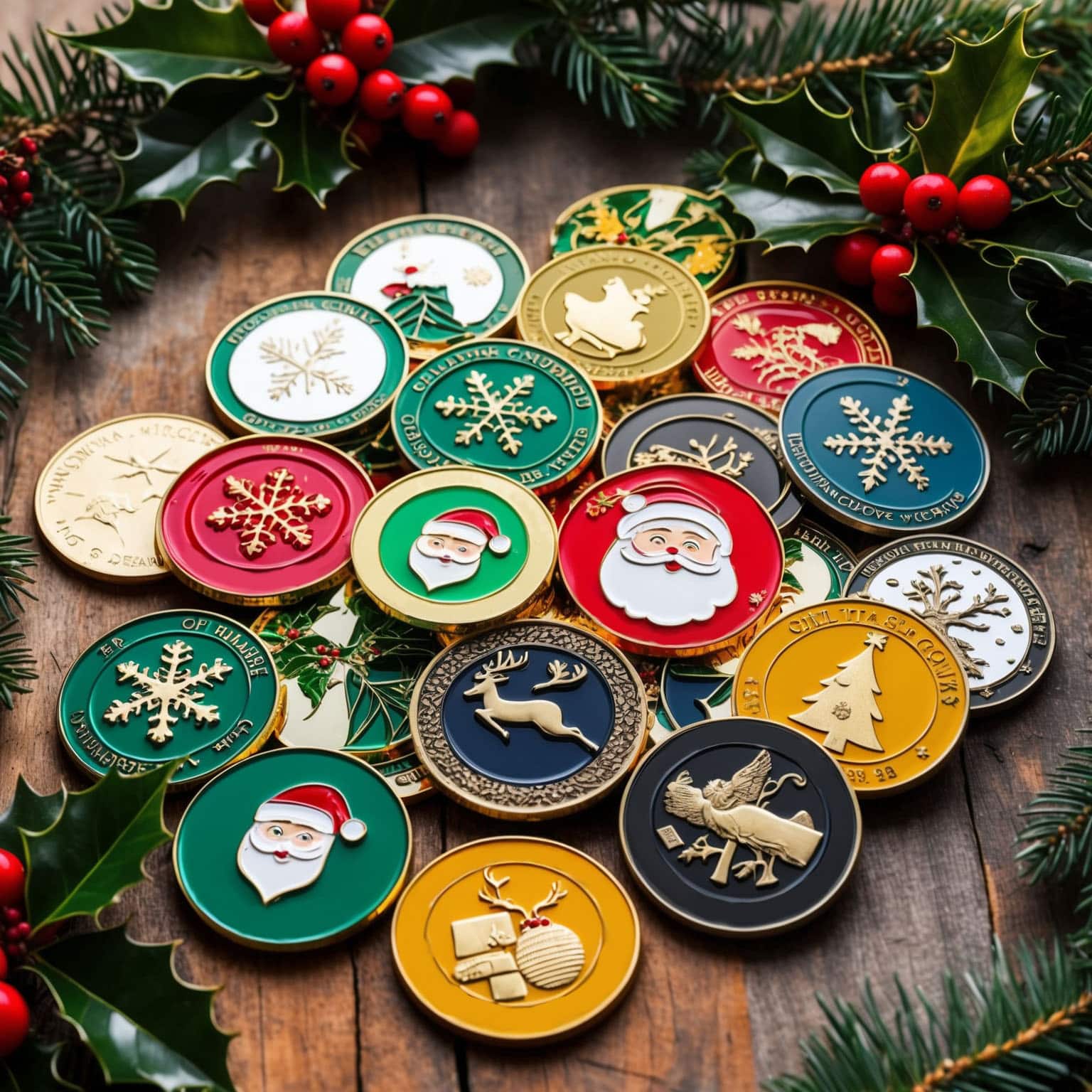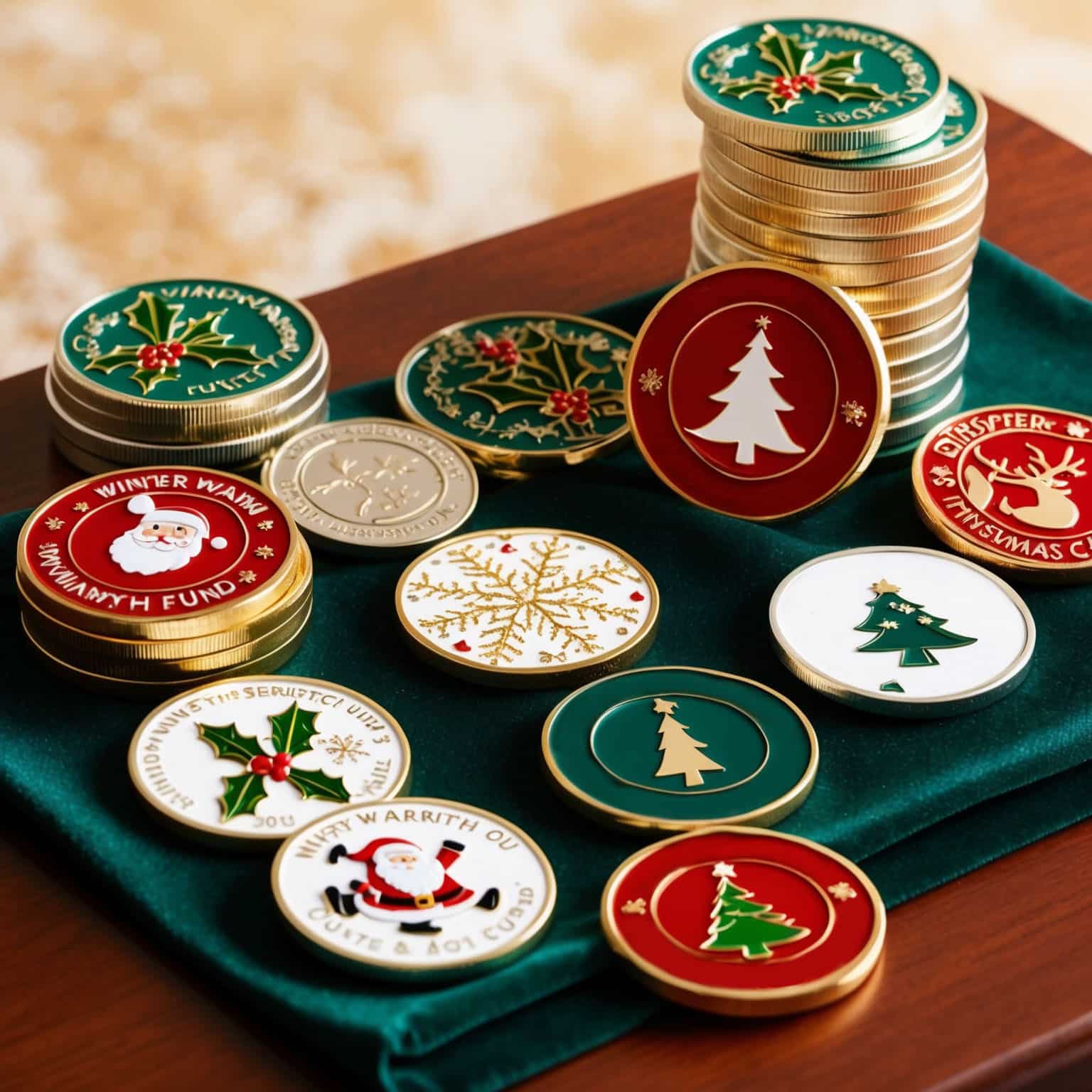Challenge coins have long held a place of honor in military and organizational traditions, serving as symbols of unity, recognition, and accomplishment. While their origins are often traced back to military use, challenge coins have since transcended borders, finding their way into a variety of cultural, professional, and personal contexts worldwide. Each coin tells a unique story, representing the values, achievements, and identities of the groups that create and exchange them. In this article, we embark on a journey to explore some of the most rare and unique challenge coins from across the globe, uncovering the rich history, cultural significance, and diverse designs that make these coins so special.
The Origins and Evolution of Challenge Coins
The Birth of a Tradition
The tradition of challenge coins is believed to have originated in the military, with stories dating back to World War I. These coins were initially used as tokens of camaraderie, given to soldiers as a symbol of their unit or to commemorate specific missions or achievements.
- Military Roots: One popular legend suggests that a wealthy lieutenant had bronze medallions minted for his squadron during World War I. One pilot, shot down and captured by enemy forces, used his medallion to prove his identity and was spared execution. This story highlights the importance of challenge coins as symbols of identity and belonging.
- Spread to Other Sectors: Over time, the use of challenge coins expanded beyond the military to include law enforcement, fire departments, government agencies, corporations, and even civilian organizations. Today, challenge coins are used to recognize achievements, build team spirit, and promote organizational values across a wide range of contexts.
The Globalization of Challenge Coins
As challenge coins have spread across the globe, they have taken on new meanings and significance in different cultural and professional settings. Each country and organization that adopts the tradition brings its own unique twist to the design and use of these coins.
- Cultural Adaptations: In some cultures, challenge coins are infused with traditional symbols, colors, and motifs that reflect the heritage and values of the group. For example, coins from Asian countries might incorporate elements of feng shui or traditional calligraphy, while coins from African nations might feature symbols of unity and strength.
- Professional Applications: Beyond military and government use, challenge coins have found a place in various professional sectors, including healthcare, education, and corporate leadership. Each sector adapts the tradition to fit its specific needs and values, resulting in a wide variety of unique challenge coins.
Exploring Rare and Unique Challenge Coins Around the World
1. United States: Presidential Challenge Coins
One of the most prestigious and widely recognized challenge coins in the United States is the Presidential Challenge Coin. These coins are traditionally given by the President of the United States to military personnel, dignitaries, and other individuals as a token of appreciation and recognition.
- Design Elements: Presidential Challenge Coins often feature the seal of the President, the American flag, and other patriotic symbols. Each President has their own unique design, making these coins highly collectible and sought after.
- Cultural Significance: Receiving a Presidential Challenge Coin is considered a great honor, symbolizing recognition from the highest office in the land. These coins are often given during special ceremonies, state visits, or when the President visits military installations.
2. United Kingdom: The Royal Navy Challenge Coin
The Royal Navy of the United Kingdom has a long and storied history, and its challenge coins are steeped in tradition. These coins are typically presented to sailors, officers, and other personnel in recognition of their service and accomplishments.
- Design Elements: Royal Navy Challenge Coins often feature the anchor, the Union Jack, and other maritime symbols. Some coins also include the crest of specific ships or units, adding a personalized touch to the design.
- Cultural Significance: In the Royal Navy, challenge coins are used to build camaraderie and morale among the crew. They are often exchanged during ceremonies, deployments, and international missions, serving as a reminder of the shared experiences and bonds formed at sea.
3. Japan: Samurai Spirit Challenge Coins
In Japan, challenge coins have been adapted to reflect the country’s rich cultural heritage, particularly the values of honor, loyalty, and discipline associated with the samurai. These coins are often used by law enforcement, the Self-Defense Forces, and other organizations.
- Design Elements: Samurai Spirit Challenge Coins typically feature imagery related to the samurai, such as swords, armor, and the chrysanthemum flower, which is a symbol of the Japanese imperial family. The coins often incorporate kanji characters that represent virtues like courage, respect, and honor.
- Cultural Significance: These coins are highly valued in Japan for their representation of the samurai spirit, which continues to influence modern Japanese society. They are often given as tokens of respect and recognition for acts of bravery, service, and dedication.
4. Germany: Bundeswehr Unit Coins
The Bundeswehr, Germany’s unified armed forces, has embraced the tradition of challenge coins, creating unique designs that reflect the history and culture of the country. These coins are used to recognize the achievements and service of soldiers and units.
- Design Elements: Bundeswehr Unit Coins often feature the Iron Cross, the national eagle, and other symbols associated with German military history. Some coins also include the insignia of specific units, branches, or missions, making each coin unique to its recipients.
- Cultural Significance: In the Bundeswehr, challenge coins are used to build unit cohesion and recognize individual contributions. They are often exchanged during joint operations with NATO allies, symbolizing the close cooperation and shared values between the forces.
5. Canada: Royal Canadian Mounted Police (RCMP) Challenge Coins
The Royal Canadian Mounted Police (RCMP) is one of Canada’s most iconic institutions, and its challenge coins reflect the pride and tradition associated with this storied organization. RCMP challenge coins are used to honor officers, commemorate special events, and build team spirit.
- Design Elements: RCMP Challenge Coins often feature the iconic red serge uniform, the maple leaf, and the RCMP crest. Some coins also include imagery related to the specific divisions or operations, such as the musical ride or international peacekeeping missions.
- Cultural Significance: RCMP Challenge Coins are highly valued as symbols of service and dedication to Canada. They are often presented to officers who have demonstrated exceptional courage, leadership, or commitment to their duties, reinforcing the values of the force.
6. South Africa: Conservation Challenge Coins
In South Africa, challenge coins are used not only in military and law enforcement contexts but also in conservation efforts. These unique coins are often created to raise awareness and funds for wildlife conservation projects, particularly those focused on protecting endangered species.
- Design Elements: Conservation Challenge Coins from South Africa typically feature images of the country’s iconic wildlife, such as elephants, rhinos, and lions. The coins may also include the logos of conservation organizations and slogans promoting environmental stewardship.
- Cultural Significance: These coins serve as a powerful tool for raising awareness about conservation issues and inspiring action. They are often sold or distributed as part of fundraising campaigns, with proceeds supporting efforts to protect South Africa’s rich biodiversity.
7. Australia: ANZAC Challenge Coins
Australia has a strong tradition of honoring its military history, particularly through the commemoration of ANZAC Day, which honors the members of the Australian and New Zealand Army Corps (ANZAC) who served in World War I. ANZAC Challenge Coins are a unique way of preserving and celebrating this legacy.
- Design Elements: ANZAC Challenge Coins often feature the rising sun badge, poppies, and the silhouette of soldiers, reflecting the themes of remembrance and sacrifice. The coins may also include the names of specific battles or campaigns, such as Gallipoli or the Western Front.
- Cultural Significance: ANZAC Challenge Coins are cherished as symbols of national pride and collective memory. They are often exchanged during ANZAC Day ceremonies, military reunions, and other events that honor the service and sacrifice of Australian and New Zealand soldiers.
8. Israel: IDF Unit Challenge Coins
The Israel Defense Forces (IDF) has a long-standing tradition of using challenge coins to build unit cohesion and recognize the contributions of soldiers. These coins are highly valued in Israeli society for their representation of military service and national security.
- Design Elements: IDF Unit Challenge Coins often feature the Star of David, the menorah, and symbols associated with specific units, such as tanks, fighter jets, or naval ships. The coins may also include Hebrew inscriptions that convey messages of strength, courage, and defense.
- Cultural Significance: In Israel, challenge coins are seen as a badge of honor, symbolizing the commitment and dedication of those who serve in the IDF. They are often presented to soldiers who have excelled in their duties or participated in significant operations, reinforcing the values of service and protection.
9. India: Armed Forces Challenge Coins
India’s rich cultural history and diverse traditions are reflected in the unique challenge coins produced by its armed forces. These coins are not just tokens of military pride; they are intricate pieces of art that honor the country’s heritage, values, and military accomplishments.
- Design and Symbolism: Indian armed forces challenge coins often feature symbols such as the national emblem, Ashoka Chakra, regimental insignias, and traditional motifs like the lotus or peacock. Each design is carefully chosen to reflect the ethos of the unit and the nation it represents. The use of vibrant colors and detailed engravings further enhances the aesthetic appeal of these coins.
- Cultural Influence: The coins also embody the diverse cultural influences of India, incorporating elements from various regions and religions. For example, coins from regiments in northern India might feature motifs from Sikhism, while those from southern units might include Dravidian symbols. This cultural richness makes Indian armed forces challenge coins particularly unique and collectible.
- Commemorating Military Achievements: These challenge coins are often issued to commemorate significant military campaigns, anniversaries, or the formation of new regiments. They serve as a symbol of honor for soldiers who have displayed exceptional courage and dedication in the service of the nation.
10. Russia: Soviet-Era Challenge Coins
In Russia, the tradition of creating challenge coins dates back to the Soviet era. These coins, often known as “znak,” were used to recognize military and civilian achievements during the Soviet Union’s reign. Even today, Russian challenge coins are highly sought after for their historical significance and distinct designs.
- Soviet Symbolism: Soviet-era challenge coins are characterized by their use of Communist symbols such as the hammer and sickle, the red star, and the portraits of Soviet leaders like Lenin and Stalin. These coins often commemorate important events in Soviet history, such as victories in World War II, space exploration milestones, and significant political anniversaries.
- Cold War Legacy: Challenge coins from this period often carry the weight of Cold War history, representing the ideological battle between the Soviet Union and the West. Coins commemorating military units stationed in Eastern Europe or those involved in significant Cold War confrontations are particularly valued by collectors.
- Post-Soviet Revival: In the post-Soviet era, Russia continues to produce challenge coins, now reflecting the achievements of the modern Russian Federation. These coins often feature imagery that blends Soviet nostalgia with new Russian patriotism, making them unique artifacts of a country in transition.
11. Japan: Self-Defense Forces and Cultural Heritage
Japan’s approach to challenge coins is deeply influenced by its culture of precision, honor, and respect for tradition. Japanese Self-Defense Forces (JSDF) challenge coins are known for their meticulous craftsmanship and unique blend of modern military imagery with ancient cultural symbols.
- Design Excellence: Japanese challenge coins often feature intricate designs that include the JSDF insignia, cherry blossoms, samurai armor, and other symbols of Japan’s cultural heritage. The coins are usually made with high-quality materials, reflecting the Japanese commitment to craftsmanship.
- Cultural Integration: The integration of traditional Japanese symbols such as the torii gate (a traditional Japanese gate found at the entrance of Shinto shrines) or the koi fish (a symbol of perseverance and strength) makes these coins stand out. This cultural integration serves to remind service members of their national heritage and the values they uphold.
- Commemoration of Peacekeeping Missions: Japan’s post-WWII pacifist constitution has led the JSDF to focus primarily on peacekeeping missions and disaster relief operations. Many Japanese challenge coins commemorate these missions, highlighting Japan’s role in global peace and security.
12. Australia: Defense Force and Indigenous Tributes
Australia’s challenge coins reflect the nation’s proud military history as well as its deep respect for the Indigenous cultures that have inhabited the continent for millennia. Australian Defense Force (ADF) challenge coins are a testament to the country’s unique blend of modern military prowess and ancient cultural heritage.
- Military Heritage: Australian challenge coins often feature symbols of the ADF, such as the Rising Sun badge, the Union Jack, and the Southern Cross constellation. These symbols are powerful reminders of Australia’s role in global conflicts, from World War I to modern-day peacekeeping missions.
- Indigenous Influence: Some challenge coins in Australia also incorporate Indigenous art and symbols, paying homage to the country’s Aboriginal and Torres Strait Islander peoples. These coins may feature traditional dot painting, boomerangs, or the Rainbow Serpent, blending Australia’s ancient cultures with its modern military identity.
- Commemorative Coins: Australia produces challenge coins to commemorate significant military events, such as ANZAC Day or the Battle of Gallipoli. These coins are highly valued for their historical significance and are often collected by veterans and history enthusiasts alike.
13. South Africa: Military and Commemorative Coins
South Africa’s challenge coins reflect the country’s complex history and its transition from apartheid to a modern democratic state. South African National Defence Force (SANDF) coins often carry deep historical significance and are rich in symbolism.
- Apartheid-Era Coins: During the apartheid era, challenge coins were used within the military and police forces to recognize service and loyalty. These coins often featured symbols of the apartheid regime, making them controversial yet historically significant collectibles.
- Post-Apartheid Transformation: In the post-apartheid era, South Africa’s challenge coins have evolved to reflect the nation’s commitment to democracy, unity, and reconciliation. Modern coins often feature the South African coat of arms, the national flag, and symbols of peace and progress.
- Cultural Diversity: South Africa’s challenge coins also celebrate the country’s rich cultural diversity. Coins may include designs that reflect the country’s various ethnic groups, languages, and traditions, making them a unique representation of the “Rainbow Nation.”
14. Brazil: Military Honors and National Pride
Brazil’s challenge coins are a testament to the country’s strong sense of national pride and its military traditions. The Brazilian Armed Forces produce challenge coins that honor the country’s achievements and its role in regional and global security.
- National Symbols: Brazilian challenge coins often feature national symbols such as the Ordem e Progresso (Order and Progress) banner, the national flag, and the Christ the Redeemer statue. These symbols reflect Brazil’s identity as a diverse and vibrant nation with a deep commitment to progress and unity.
- Military Commemorations: Many Brazilian challenge coins are produced to commemorate military achievements, such as participation in United Nations peacekeeping missions or successful counter-narcotics operations. These coins are prized by service members and collectors for their representation of Brazil’s contributions to global peace and security.
- Carnival and Cultural Elements: Some Brazilian challenge coins incorporate elements of the country’s rich cultural heritage, such as Carnival motifs, samba dancers, or indigenous art. These coins celebrate Brazil’s unique cultural identity and its influence on the global stage.
15. Israel: Defense Force and Cultural Heritage
The Israel Defense Forces (IDF) are known for their highly disciplined and technologically advanced military, and their challenge coins reflect these qualities. Israeli challenge coins are not only symbols of military pride but also deeply connected to the country’s history and cultural heritage.
- Military Innovation: Israeli challenge coins often highlight the country’s military innovations, such as advanced weaponry, technology, and elite units like the Mossad and the Golani Brigade. These coins serve as symbols of Israel’s commitment to defending its borders and maintaining national security.
- Cultural and Religious Symbols: Many Israeli challenge coins feature symbols from Jewish history and religion, such as the Star of David, the Menorah, and images of Jerusalem. These coins reflect the deep connection between Israel’s military and its cultural and religious identity.
- Commemorative Coins: Israel produces challenge coins to commemorate significant military operations, anniversaries, and partnerships with other nations. These coins are valued not only for their military significance but also for their connection to Israel’s ongoing struggle for peace and security in the region.
16. New Zealand: Defense Force and Maori Culture
New Zealand’s challenge coins are a unique blend of military tradition and Maori cultural heritage. The New Zealand Defence Force (NZDF) produces challenge coins that honor the country’s military achievements and its deep respect for the indigenous Maori culture.
- Military Symbols: New Zealand challenge coins often feature symbols of the NZDF, such as the Kiwi bird, the Silver Fern, and the NZDF emblem. These symbols are a source of pride for service members and represent New Zealand’s commitment to global peacekeeping efforts.
- Maori Influence: Many New Zealand challenge coins incorporate Maori symbols and art, such as the koru (spiral) design, which represents new life and growth, and the tiki, a symbol of protection. These elements celebrate New Zealand’s cultural diversity and the important role of the Maori people in the country’s identity.
- Commemorative Coins: New Zealand produces challenge coins to commemorate significant military events, such as participation in World War I and II, as well as peacekeeping missions in the Pacific region. These coins are highly valued by veterans, collectors, and those with an interest in New Zealand’s military history.
The Global Appeal of Unique Challenge Coins
Challenge coins have evolved from military traditions into global symbols of pride, achievement, and cultural identity. Their appeal transcends borders, with each coin telling a unique story of the people, organizations, and events it represents.
A Collector’s Dream
For collectors, challenge coins offer a window into the diverse cultures, histories, and traditions of nations around the world. The uniqueness of each coin, from its design elements to its cultural significance, makes it a valuable addition to any collection. Collectors often seek out rare and limited-edition coins, which can serve as both historical artifacts and works of art.
The Future of Challenge Coins
As the world becomes increasingly interconnected, the tradition of challenge coins is likely to continue evolving, with new designs and cultural influences emerging. Advances in technology, such as 3D printing and augmented reality, may lead to even more innovative and personalized challenge coins, further enhancing their appeal to collectors and enthusiasts.
The Role of Challenge Coins in Diplomacy and Cultural Exchange
Challenge coins also play a role in diplomacy and cultural exchange, serving as gifts and tokens of goodwill between nations and organizations. These coins can symbolize partnerships, shared values, and mutual respect, fostering stronger relationships across borders.
Conclusion
Challenge coins are more than just military tokens; they are powerful symbols of identity, achievement, and cultural heritage. As we journey through the diverse and unique challenge coins from around the globe, we see how these small, yet significant items reflect the values, history, and traditions of the nations they represent. Whether used to commemorate military achievements, celebrate cultural heritage, or foster international relations, challenge coins continue to hold a special place in the hearts of those who receive and collect them.
If you are interested in a unique challenge coin, you can call us at 800-371-6256 or fill out a FREE quote form.








